ABSTRACT
The collection of reliability and maintainability (RM) data in compliance with the International Standard ‘ISO 14224 Petroleum, petrochemical and natural gas industries — Collection and exchange of reliability and maintenance data for equipment’ provides a standardised format for collecting failure and maintenance data during the operational life cycle of equipment. Additionally, it sets the foundation for a consistent tracking of failures and maintenance records, allowing the prioritization and implementation of corrective actions. This results in the improvement of equipment reliability and maintenance optimization. The thorough analysis of reliability and maintainability data, normally derived from a CMMS and hopefully based on an automated system, provides a wide-range of benefits, including the opportunity to optimize the timing of equipment overhauls and inspections and the content of maintenance procedures, to reduce the equipment failures as well as the life cycle costing of sparing, and to upgrade maintenance programmes in all types of operating facilities world-wide.
INTRODUCTION
In the oil and gas industries improvement in the level of equipment reliability can lead to significant financial reward. Such reliability improvements can result from an understanding of the causes of failures and from a goal-oriented reliability and maintenance (RM) data analysis. These are key elements in prioritizing and implementing corrective actions.
Major oil exploration companies have moved toward Reliability Centred Maintenance (RCM) practices, an approach to achieving maintenance strategy improvement that incorporates failure analysis that can be successfully supported by compliance with ISO 14224. The International Standard ISO 14224 ‘Petroleum, petrochemical and natural gas industries — Collection and exchange of reliability and maintenance data for equipment’ provides a consistent structure for setting up and collecting RM data and also sets a foundation for consistent tracking of failures.
APPLICATION
ISO 14224 focuses on the data required for use in various analyses and on standardized data collection format for facilitating the exchange of RM data throughout the operational life cycle. It is applicable to equipment types used in the petroleum, petrochemical and natural gas sectors. Due to the high costs of collecting and maintaining RM data it is necessary to balance the effort against the intended use and benefits.
BENEFITS
The analysis of RM data provides a wide-range of benefits, including the opportunity to optimize the timing of equipment overhauls and inspections and the content of maintenance procedures, as well as minimising the life cycle costing of sparing and of upgrade programmes in operating facilities. It can also improve the decision-making process, reduce the incidence of catastrophic failures, mitigate environmental impacts, support more effective benchmarking and performance trending and ultimately improve availability.
COLLECTION OF RM DATA
Prior to the data collection process a set of planning measures needs to be completed to ensure that consistent and compatible data are obtained.
Data collection plan
1. Define the objective for data collection. RM data can be applied in different areas and analyses,. as presented in Table 1.
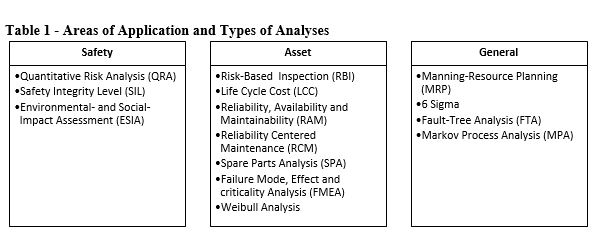
ISO 14224 Annex D establishes the equipment, failure and maintenance data required for each intended use.
2. Investigate the source(s) of the data to confirm that adequate data quality is provided.
High quality data –
- are complete according to specification;
- comply with standard definitions (reliability parameters, data types and formats);
- have accurate input, transfer, handling and storage;
- give statistical confidence (sufficient population and adequate surveillance period);
- are relevant to intended purpose.
3. Define for each equipment unit the taxonomical information to be considered. The systematic classification (taxonomy) enables RM data to be meaningful and comparable. The taxonomy of data established by the ISO 14224 is shown in Figure 1.
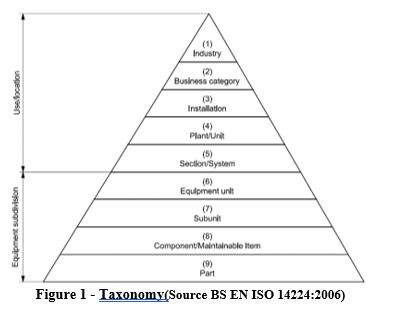
Levels 1 to 5 represent a high-level categorization that relates to industries and plant application. Levels 6 to 9 are related to the equipment unit (inventory) with subdivision in lower indenture levels corresponding to a parent-child relationship.
4. Identify the installation date, population and operating period(s) for the equipment considered. Timeline definition is presented in Table 2.
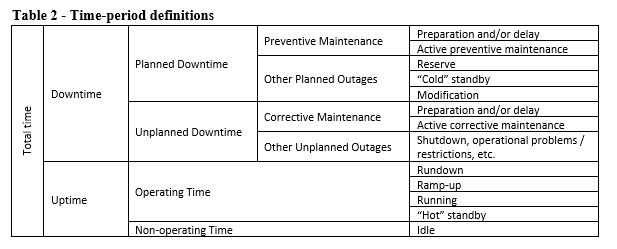
5. Define the boundaries for each equipment class, indicating what RM data are to be collected. A clear description of the interface between an item and its surroundings (boundary) is necessary for collecting, merging and analysing compatible RM data from different industries, plants or sources. ISO 14224 Annex A presents recommended boundary diagrams for selected equipment units.
6. Apply a uniform definition of failure and a method of classifying failures. ISO 14224 defines failure as the termination of the ability of an item to perform a required function. The failure data is characterized by the identification data and failure data for characterizing a failure, as presented in Table 3. The standard establishes the minimum data needed.
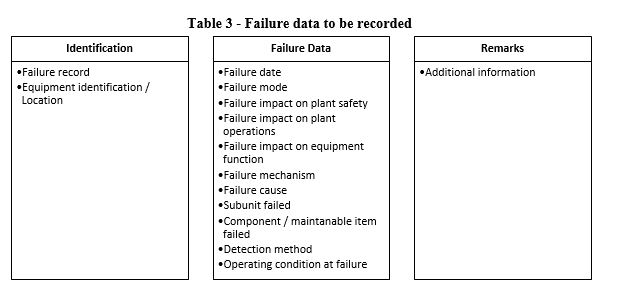
7. Apply a uniform definition of failure maintenance and a method of classifying maintenance failures. ISO 14224 defines maintenance as the combination of all technical and administrative actions, including supervisory actions, intended to retain an item in, or restore it to, a state in which it can perform a required function. It is divided into two categories: corrective and preventive The data to be recorded are listed in Table 4.
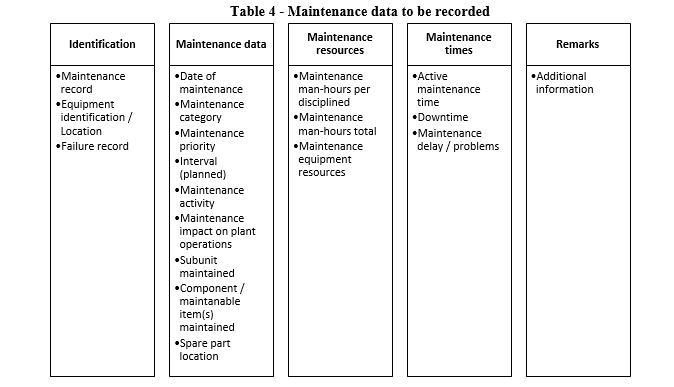
8. Define the checks to be used in data quality verification. During and after the data collection, the data is analysed to verify consistency, reasonable distributions, proper codes and correct interpretations. ISO 14224 requires, at a minimum, verification that –
- origin of data is documented and traceable;
- data come from similar equipment type, technology and operating conditions;
- equipment is relevant for the purpose (e.g. not outdated models);
- data follows definitions and interpretation rules (e.g. definition of failure);
- recorded failures are within equipment boundary and surveillance period;
- information is consistent (e.g. consistent between failure modes and impact);
- data are registered in the correct format;
- data volume collected gives acceptable statistical confidence;
- operating and maintenance personnel are consulted to validate the data.
9. Define a priority level for the completeness of data by a suitable method, such as using three classes of importance:
- High: compulsory data (coverage ≈ 100 %);
- Medium: highly desirable data (coverage > 75 %);
- Low: desirable data (coverage > 50 %).
10. Define the level of detail of RM data reported and collected. Relate the level of detail closely to the production and safety importance of the equipment. Prioritise based on safety, regulatory and/or other severity measures.
11. Prepare the plan for data collection, including schedules, milestones, data collection sequence for installations and equipment units, surveillance periods to be covered, etc.
12. Plan data assembly and report and define suitable method for transfer of the data from source to reliability database. The data collection process typically consists of compiling data from different sources into one database where the type and the format of the data are pre-defined, as follows:
- Address all available data sources and extract the relevant ‘raw’ data into an intermediate storage;
- Interpret information and convert it into the database type and format;
- Transfer the data from the source(s) to the reliability database using a suitable method;
- Carefully plan and test data collection method before starting the main process, since these methods significantly impact the cost benefit analysis for data collection.
13. Train, motivate and organize the datacollection personnel, ensuring in-depth understanding of the equipment, its operating conditions, ISO 14224 and the requirements for data quality.
14. Prepare a plan for quality assurance of the data collection process and its deliverables. ISO 14224 establishes, as a minimum, procedures for quality control of the data and for recording and correction of deviations.
15. ISO 14224 recommends performing a cost benefit analysis of the data collection by running a pilot exercise before the main data collection phase is started. Based on the results, revising the plan, if necessary, is recommended.
16. Review the planning measures after a period of using the system.
Data collection process
Before data collection, it is recommended to conduct a pilot exercise to verify feasibility of the actions established in the plans (available population, quality of source information and feasibility of the data collection methods).
For the data collection process, a system for dealing with deviations encountered shall be established and problems solved as soon as possible.
Lastly, all quality lessons learned during the planning and execution of the data collection effort shall be evaluated and summarized. Recommendations shall then be forwarded for improvement on the process.
CONCLUSIONS
The International Standard presents a comprehensive basis for the collection and exchange of RM data. Compliance with ISO 14224 provides a systematic approach for data collection, resulting in improved quality of data.
Consistent RM data enables a clearer understanding of the equipment technical characteristics, its operating and environmental conditions, its potential failures and its maintenance activities. As a result, reliability analyses can be more effective and decisive, enhancing the level of equipment reliability.
REFERENCES
BS EN ISO 14224:2006. Collection and exchange of reliability and maintenance data for equipment, BSI, 2007.
Hussin H. et al. Systematic approach to maintainability analysis at operational phase. Journal of Applied Sciences, 12: 2562-2567, 2012.
Sahlqvist,J, IFS White Paper: Facilitating ISO 14224 with EAM software. February 2004

